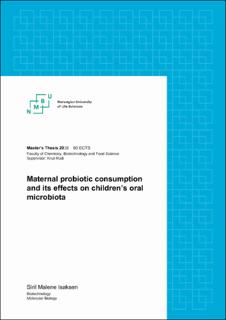| dc.contributor.advisor | Rudi, Knut | |
| dc.contributor.author | Isaksen, Siril Malene | |
| dc.date.accessioned | 2020-05-04T10:29:24Z | |
| dc.date.available | 2020-05-04T10:29:24Z | |
| dc.date.issued | 2018 | |
| dc.identifier.uri | https://hdl.handle.net/11250/2653175 | |
| dc.description.abstract | Omtrent halvparten av alle cellene i kroppen vår er av prokaryotisk opprinnelse, og vi vet at den mikrobielle sammensetningen påvirker helsen vår. Denne kunnskapen kan brukes til å endre den mikrobielle sammensetningen slik at den fungerer til vår fordel. Den orale mikrobiotaen er den nest mest omfattende etter mage-tarmkanalens mikrobiota. Den beskytter kroppene mot uønsket stimulering fra utsiden, og tidligere studier har vist at probiotisk behandling av gravide fører til en reduksjon i tilfeller av atopisk eksem hos deres barn. En av de mulige veiene de probiotiske bakteriene overføres fra mor til barn er gjennom munnen. Formålet med denne oppgaven er derfor å avgjøre om inntak av probiotika kan endre den orale mikrobiotaen hos mødre og deres barn.
De 878 prøvene som ble brukt i denne oppgaven var fra Prevention of Allergy among Children in Trondheim (Pro-PACT) studien. Spyttprøver ble samlet inn fra både mødre og barn både 10 dager og 3 måneder etter fødsel. Sekvensering ble brukt til å bestemme sammensetningen til den orale mikrobiotaen i disse prøvene.
Den probiotiske behandlingen til mødrene ser ikke ut til å ha noen større effekt på den orale mikrobiotaen hos barna. Sammensetningen av barns orale mikrobiota korresponderte med funn i tidligere studier, de mest omfattende phylaene var Firmicutes, Proteobacteria, Fusobacteria og Actinobacteria. En av de mindre skilnadne som ble funnet hos barna var i slekten Gemella. Barna fra de mødrene som fikk placebobehandling hadde dobbelt så mange sekvenser fra denne slekten enn de andre barna. Det probiotiske forbruket hos mødre synes å påvirke deres orale mikrobiota basert på de 20 artene det var mest av i alle prøvene. | en_US |
| dc.description.abstract | Approximately half of the cells in our bodies are of prokaryotic origin, and we know that the microbial composition influences our health. This knowledge can be used to work out how we can alter the microbial composition to our benefit. The oral microbiota is the second most abundant one after the gastrointestinal gut, and it protects our bodies from unwanted stimulation from the outside. Earlier studies have shown that probiotic consumption by pregnant women lead to a decrease in cases of atopic dermatitis in their children. One of the possible transmission paths of the probiotic bacteria from mother to child is though the oral cavity. The aim of this thesis is therefore to determine if probiotic intervention can alter the oral microbiota in mothers and their children.
The 878 samples used in this thesis were from the Prevention of Allergy among Children in Trondheim (Pro-PACT) study. Saliva samples were collected at 10 days postpartum and 3 months postpartum from both the mothers and their children. Sequencing were used to determine the oral microbiota in these samples.
The probiotic treatments of the mothers did not seem to have any major effect on the oral microbiota in the children. The composition of the children’s oral microbiota corresponded to findings in earlier studies, with the most abundant phyla being Firmicutes, Proteobacteria, Fusobacteria and Actinobacteria. One small difference found in the children were the genus Gemella having twice as high quantities in the children from mothers who received placebo treatment, then in the children whose mothers were treated with probiotics. The probiotic consumption in mothers seems to influence their oral microbiota based on the 20 most abundant species in the community. | en_US |
| dc.language.iso | eng | en_US |
| dc.publisher | Norwegian University of Life Sciences, Ås | en_US |
| dc.rights | Attribution-NonCommercial-NoDerivatives 4.0 Internasjonal | * |
| dc.rights.uri | http://creativecommons.org/licenses/by-nc-nd/4.0/deed.no | * |
| dc.title | Maternal probiotic consumption and its effects on children's oral microbiota | en_US |
| dc.type | Master thesis | en_US |
| dc.description.localcode | M-BIOTEK | en_US |

